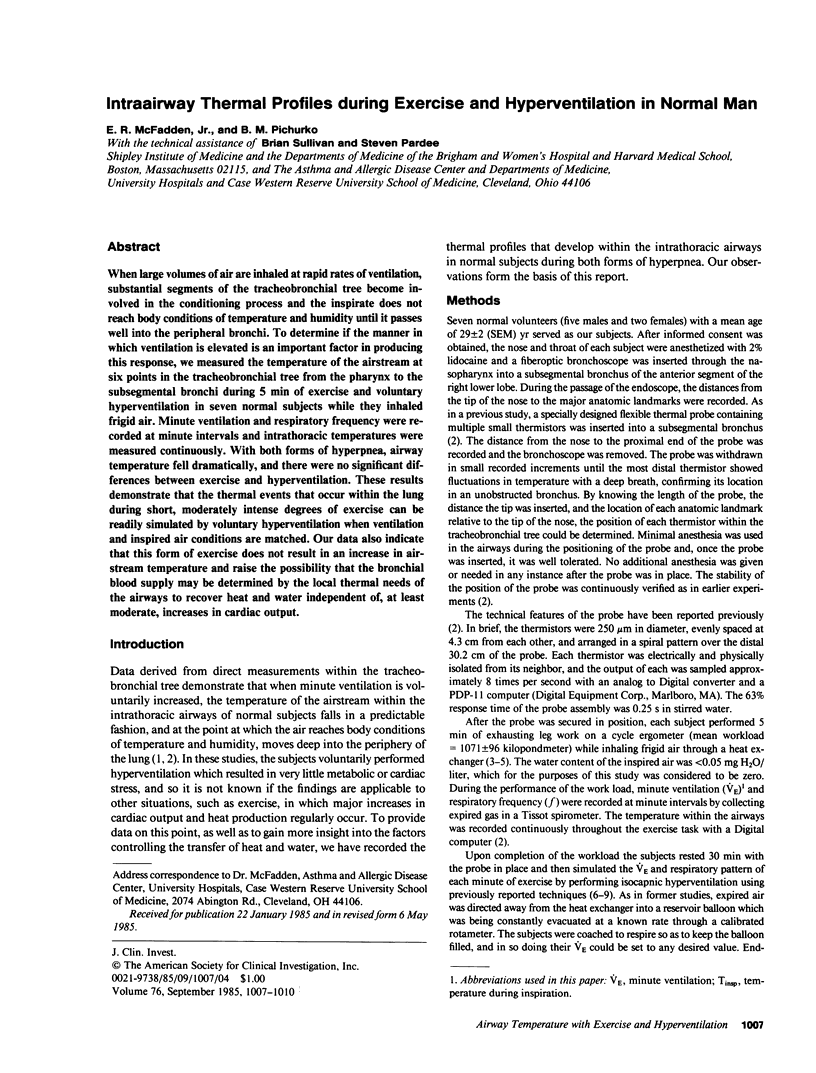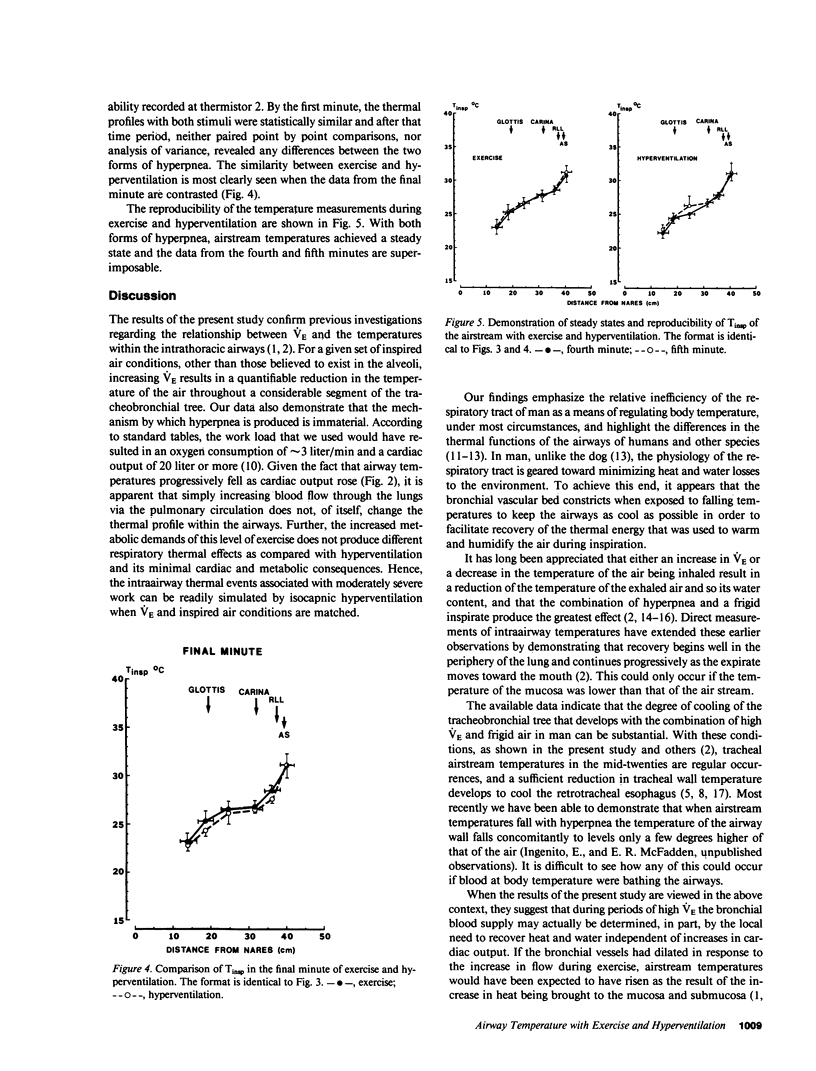Abstract
When large volumes of air are inhaled at rapid rates of ventilation, substantial segments of the tracheobronchial tree become involved in the conditioning process and the inspirate does not reach body conditions of temperature and humidity until it passes well into the peripheral bronchi. To determine if the manner in which ventilation is elevated is an important factor in producing this response, we measured the temperature of the airstream at six points in the tracheobronchial tree from the pharynx to the subsegmental bronchi during 5 min of exercise and voluntary hyperventilation in seven normal subjects while they inhaled frigid air. Minute ventilation and respiratory frequency were recorded at minute intervals and intrathoracic temperatures were measured continuously. With both forms of hyperpnea, airway temperature fell dramatically, and there were no significant differences between exercise and hyperventilation. These results demonstrate that the thermal events that occur within the lung during short, moderately intense degrees of exercise can be readily simulated by voluntary hyperventilation when ventilation and inspired air conditions are matched. Our data also indicate that this form of exercise does not result in an increase in airstream temperature and raise the possibility that the bronchial blood supply may be determined by the local thermal needs of the airways to recover heat and water independent of, at least moderate, increases in cardiac output.
Full text
PDF



Selected References
These references are in PubMed. This may not be the complete list of references from this article.
- Baile E. M., Dahlby R. W., Wiggs B. R., Paré P. D. Role of tracheal and bronchial circulation in respiratory heat exchange. J Appl Physiol (1985) 1985 Jan;58(1):217–222. doi: 10.1152/jappl.1985.58.1.217. [DOI] [PubMed] [Google Scholar]
- Breslin F. J., McFadden E. R., Jr, Ingram R. H., Jr, Deal E. C., Jr Effects of atropine on respiratory heat loss in asthma. J Appl Physiol Respir Environ Exerc Physiol. 1980 Apr;48(4):619–623. doi: 10.1152/jappl.1980.48.4.619. [DOI] [PubMed] [Google Scholar]
- COLE P. Further observations on the conditioning of respiratory air. J Laryngol Otol. 1953 Nov;67(11):669–681. doi: 10.1017/s0022215100049161. [DOI] [PubMed] [Google Scholar]
- COLE P. Recordings of respiratory air temperature. J Laryngol Otol. 1954 May;68(5):295–307. doi: 10.1017/s0022215100049690. [DOI] [PubMed] [Google Scholar]
- CRANSTON W. I., GERBRANDY J., SNELL E. S. Oral, rectal and oesophageal temperatures and some factors affecting them in man. J Physiol. 1954 Nov 29;126(2):347–358. doi: 10.1113/jphysiol.1954.sp005214. [DOI] [PMC free article] [PubMed] [Google Scholar]
- Deal E. C., Jr, McFadden E. R., Jr, Ingram R. H., Jr, Breslin F. J., Jaeger J. J. Airway responsiveness to cold air and hyperpnea in normal subjects and in those with hay fever and asthma. Am Rev Respir Dis. 1980 Apr;121(4):621–628. doi: 10.1164/arrd.1980.121.4.621. [DOI] [PubMed] [Google Scholar]
- Deal E. C., Jr, McFadden E. R., Jr, Ingram R. H., Jr, Jaeger J. J. Esophageal temperature during exercise in asthmatic and nonasthmatic subjects. J Appl Physiol Respir Environ Exerc Physiol. 1979 Mar;46(3):484–490. doi: 10.1152/jappl.1979.46.3.484. [DOI] [PubMed] [Google Scholar]
- Deal E. C., Jr, McFadden E. R., Jr, Ingram R. H., Jr, Jaeger J. J. Hyperpnea and heat flux: initial reaction sequence in exercise-induced asthma. J Appl Physiol Respir Environ Exerc Physiol. 1979 Mar;46(3):476–483. doi: 10.1152/jappl.1979.46.3.476. [DOI] [PubMed] [Google Scholar]
- Deal E. C., Jr, McFadden E. R., Jr, Ingram R. H., Jr, Strauss R. H., Jaeger J. J. Role of respiratory heat exchange in production of exercise-induced asthma. J Appl Physiol Respir Environ Exerc Physiol. 1979 Mar;46(3):467–475. doi: 10.1152/jappl.1979.46.3.467. [DOI] [PubMed] [Google Scholar]
- McFadden E. R., Jr, Denison D. M., Waller J. F., Assoufi B., Peacock A., Sopwith T. Direct recordings of the temperatures in the tracheobronchial tree in normal man. J Clin Invest. 1982 Mar;69(3):700–705. doi: 10.1172/JCI110498. [DOI] [PMC free article] [PubMed] [Google Scholar]
- McFadden E. R., Jr, Pichurko B. M., Bowman H. F., Ingenito E., Burns S., Dowling N., Solway J. Thermal mapping of the airways in humans. J Appl Physiol (1985) 1985 Feb;58(2):564–570. doi: 10.1152/jappl.1985.58.2.564. [DOI] [PubMed] [Google Scholar]
- Mitchell J. W., Nadel E. R., Stolwijk J. A. Respiratory weight losses during exercise. J Appl Physiol. 1972 Apr;32(4):474–476. doi: 10.1152/jappl.1972.32.4.474. [DOI] [PubMed] [Google Scholar]
- O'Cain C. F., Dowling N. B., Slutsky A. S., Hensley M. J., Strohl K. P., McFadden E. R., Jr, Ingram R. H., Jr Airway effects of respiratory heat loss in normal subjects. J Appl Physiol Respir Environ Exerc Physiol. 1980 Nov;49(5):875–880. doi: 10.1152/jappl.1980.49.5.875. [DOI] [PubMed] [Google Scholar]
- Strauss R. H., McFadden E. R., Jr, Ingram R. H., Jr, Deal E. C., Jr, Jaeger J. J. Influence of heat and humidity on the airway obstruction induced by exercise in asthma. J Clin Invest. 1978 Feb;61(2):433–440. doi: 10.1172/JCI108954. [DOI] [PMC free article] [PubMed] [Google Scholar]
- Taylor C. R. Exercise and environmental heat loads: different mechanisms for solving different problems? Int Rev Physiol. 1977;15:119–146. [PubMed] [Google Scholar]
- WEBB P. Air temperatures in respiratory tracts of resing subjects in cold. J Appl Physiol. 1951 Nov;4(5):378–382. doi: 10.1152/jappl.1951.4.5.378. [DOI] [PubMed] [Google Scholar]


